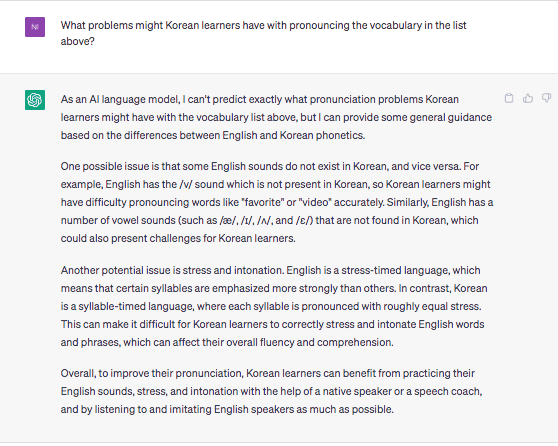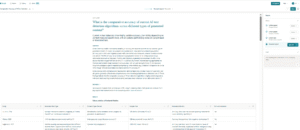As a content manager, you constantly seek ways to streamline your workflow without sacrificing quality.
The latest iteration of ChatGPT helps you achieve just that. It can make your job easier while keeping your content engaging and true to your brand’s voice.
But for that, you need to know how to transition from a traditional human content process to a more integrated AI-assisted approach
Let’s see how you can fit ChatGPT-4 fit into your content strategy with a well-thought-out prompting process.
Why ChatGPT-4 make it finally possible to generate quality content
ChatGPT in its paid GPT-4 version represents a significant advancement in AI content creation. Compared to older systems like earlier versions of GPT or other language models, it can generate consistent, compelling, and true-to-voice writing.
All thanks to new emerging capabilities :
Consistency in Reasoning

You might recall how earlier AI tools could start a topic well but then lose track, meandering into unrelated areas. Imagine starting an article on healthy eating but ending up discussing tech gadgets.
With ChatGPT-4, you won’t face this issue. Your health article will stay focused on health from start to finish, ensuring a coherent and engaging read for your audience.
Style Personalization

If you’ve used older AI models, you’ve probably noticed their one-size-fits-all approach to style. Whether drafting a corporate report or a casual blog post, the tone remained frustratingly similar.
ChatGPT-4 changes this game for you. Now, you can instruct it to match the exact tone and style you need, be it formal for a white paper or informal for a blog, aligning perfectly with your brand’s voice.
Quick Fact Synthesis and Summary

Earlier systems could provide information but often in a verbose and tangled manner. Think of getting a comprehensive report when you only needed the highlights.
ChatGPT-4, in contrast, gives you the ability to condense complex topics into clear, concise summaries. This means less time sifting through fluff and more time focusing on key information that matters to you and your readers.
The different content formats you can create with ChatGPT
Thanks to its broad personalization, ChatGPT can handle a variety of content formats. Here are the most interesting use cases :
1. Blog Posts and Articles
You’re likely familiar with the challenge of generating fresh, engaging content for your blog or website regularly. ChatGPT-4 can not only generate article ideas but also create entire posts.
Whether you’re looking for a thought leadership piece or a how-to guide, ChatGPT-4 can adapt to various topics and styles, ensuring your blog stays updated with minimal effort on your part.
2. Social Media Posts
Keeping up with the fast-paced world of social media can be daunting. ChatGPT-4 makes this easier by generating platform-specific content.
Whether it’s a catchy tweet, a detailed LinkedIn post, or a Facebook update, ChatGPT-4 understands the nuances of each platform, helping you maintain an active and relevant social media presence.
3. Email Campaigns
Email remains a powerful tool in digital marketing, and with ChatGPT-4, creating compelling email content becomes a breeze.
From promotional emails to newsletters, ChatGPT-4 can help you draft content that resonates with your audience, drives engagement, and enhances your email marketing strategy.
4. Ad Copy
If you’re running online ads, you know the importance of concise and persuasive copy.
ChatGPT-4 can assist in creating ad texts that are not only attention-grabbing but also aligned with your brand voice, making your ad campaigns more effective.
5. Product Descriptions and Reviews
E-commerce relies heavily on the quality of product descriptions and reviews. ChatGPT-4 can help you create detailed, engaging descriptions and authentic-sounding reviews, enhancing the online shopping experience for your customers.
In your content marketing journey, embracing ChatGPT-4 means you’re not just keeping up with the latest technology – you’re leveraging a versatile tool that significantly streamlines your content creation process across various formats.
The hybrid approach to ChatGPT content creation

When it comes to content production, ChatGPT-4 comes with huge productivity gains. But to leverage it, you have to significantly alter your existing content processes. Let’s see how to rearrange each stage of your content creation process with ChatGPT:
The Huge Productivity Gains of ChatGPT
I made the math to figure out the productivity gains brought by GPT-4 :
1. Research: Typically, you might spend about an hour researching a topic. With ChatGPT-4, this time remains unchanged, but the efficiency and depth of the research are enhanced. ChatGPT-4 can quickly gather and summarize information from a vast pool of knowledge, providing you with a comprehensive understanding of your subject.
2. Ideation: Where you used to invest two hours brainstorming and outlining, ChatGPT-4 cuts this down to just 20 minutes. By feeding it your basic ideas or topics, ChatGPT-4 can generate a range of concepts and potential outlines, allowing you to select and refine the ones that best fit your objectives.
3. Writing: The most significant change is in the actual writing process. What used to take you about four hours can now be done in as little as 30 minutes. With ChatGPT-4, once you provide a clear direction and style guidelines, it can produce a draft that aligns closely with your needs, saving you considerable time.
4. Editing: The editing phase still requires about an hour of your time. This is where your expertise is crucial. While ChatGPT-4 can get the basics right, it’s your job to add the human touch, ensuring the content not only reads well, but also carries your brand’s unique voice and meets your quality standards.
When you add up these times, the traditional process, which may have taken around 8 hours (1 hour for research, 2 hours for ideation, 4 hours for writing, and 1 hour for editing), is now condensed to approximately 2 hours and 50 minutes (1 hour for research, 20 minutes for ideation, 30 minutes for writing, and 1 hour for editing).
This represents a total productivity gain of about 5 hours and 10 minutes, cutting the original time by more than half.
The New Role of the Prompt-Writer
Such substantial time saving comes with a brand-new content creation role. The role of the content writer evolves from manual writing to a hybrid job called a ‘prompt-writer’.
This hybrid role is the future of content writing. It will sooner than later replace every content writer role that used to produce content by hand.
Why? Because the productivity gains are too for companies and marketing departments to ignore.
Prompt writer involves three main tasks :
- Finding the prompts that fit the brand and audience
Each content project involves different prompts. That’s because you won’t have the same expectations in terms of brand voice, writing style, and structure depending on your marketing goals.
To find the right prompts, you have thus to try and refine them on ChatGPT until it provides the right result. Having fixed and efficient prompts also enables you to get a consistent result each time.
- Researching the subject
Since GPT-4 takes care of the writing, you have now more time to focus on the quality of the material and insights you put into your content. You want to put together ideas from relevant sources, insights from subject-matter experts, and further references and documentation.
You’ll then feed these resources as input to ChatGPT.
- Supervising the process
You now supervise the AI process, applying the prompting process you defined and reviewing the quality of the result. You check every output of ChatGPT and ask it for further enhancement if necessary. You also make the final edits and integrations to make it even more engaging and compelling.
Creating content with ChatGPT: an example of prompts
Creating content with ChatGPT-4 involves a blend of strategic prompting and human creative input. Here’s a step-by-step guide to help you make the most out of this powerful tool:
1. Assigning a Role to ChatGPT

First, decide what role you want ChatGPT to play in your content creation process.
Are you looking for an assistant to produce SEO-optimized content, a copywriter to flesh out a new landing page, or a community manager to post social media updates? What is the typical profile of the audience you’re addressing?
This initial step is crucial as it sets the direction for your interaction with ChatGPT.
For example :
You are an experienced content writer for intellectualead.com. You’re writing for an audience of content marketers who want to improve the quality of their AI content output. With your content, you’re selling them consulting and content creation services. Your goal is to create SEO-optimized content that ranks on Google on the specific query we are giving you.
This prompt sets a clear objective and target audience, guiding ChatGPT in the right direction.
2. Defining Style and Format

Next, specify the style and format you’re aiming for. If your brand voice is conversational, instruct ChatGPT to mirror that.
Likewise, if you’re working on a formal report, request a more professional tone. Be clear about the content format too – whether it’s a blog, an email, or a social media post.
For example:
You must write in a conversational, helpful voice, providing action plans and concrete insights. You write short and easy-to-understand sentences. In your writing, you put your readers’ goals and concerns first by addressing them directly with the pronoun ‘you’.
This instruction ensures that ChatGPT adopts the appropriate voice and approach, making the content relatable and reader-friendly
3. Creating an Outline

This is where you get ChatGPT to lay the foundation of your content. Provide a prompt that outlines the main points or sections you want to cover. This helps in organizing the content logically and ensures that all key aspects are addressed.
For example:
Strictly following our previous instructions, draft an outline for an article about creating content with ChatGPT by making research online to come up with relevant ideas and basing yourself on this outline.
This step ensures that your content covers all necessary points in a logical order.
4. Generating Content Section-by-Section

With the outline in place, ask ChatGPT to expand each section into a detailed draft. This step-by-step approach helps in maintaining focus and depth in each part of your content. It is also necessary since ChatGPT can’t produce more than 600 words at once (it will bluntly tell you it can’t do it).
For instance :
“While strictly following the style, tone, and writing guidelines I gave you, write section 1 in 300 words.”
Then, if the result is not satisfactory, provide specific guidance for each section, like :
“Rewrite the text by cutting the fluff/being more concrete/having shorter/longer sentences/paragraphs/addressing the reader directly.”
This approach helps maintain focus and depth in each part of your content, making it engaging and informative.
By following these steps, you can harness ChatGPT-4’s capabilities to produce content at scale but also true to your brand and audience expectations !






